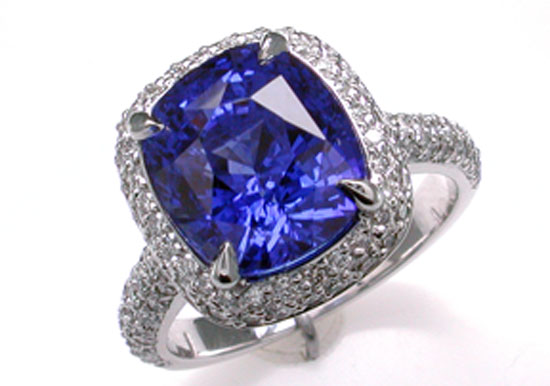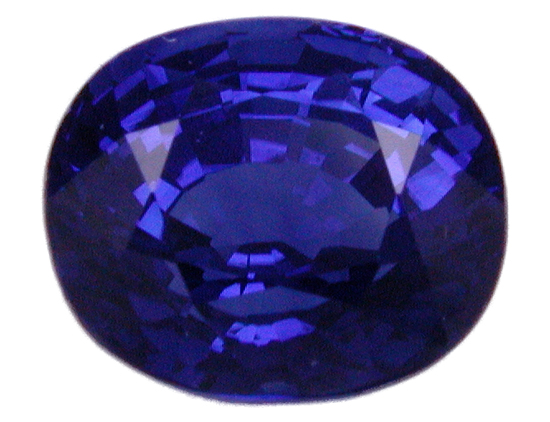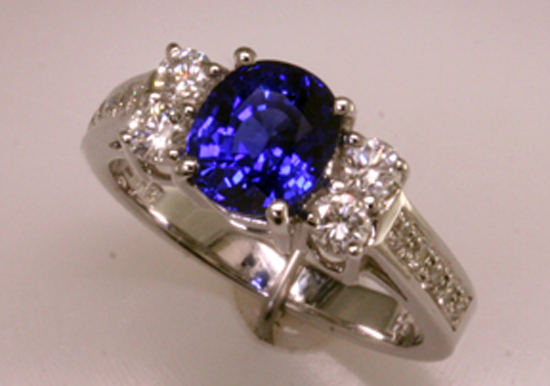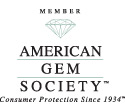What is the Best Color for Blue Sapphire? Part 3
September 10th, 2009 by James L. Sweaney, CGA, FGA. GG
Extra Fine 7 ct. Ceylon Sapphire in Mardon Custom Ring
Blue sapphires are found in many countries worldwide. The geological conditions in which they form determine the quality of the sapphire crystals. Some locales are known to produce exceptionally fine crystals, yielding extra fine gems. Each locale produces a range of gem material that shares common characteristics that are directly related to its unique geology. The unique characteristics of each source allow us to classify many sapphires by their country of origin.
Country of origin can have a significant effect on the value of a gemstone, especially when the stone is large and of fine quality. A certificate of origin from a top lab like GIA or GRS can make or break the sale of a fine stone. Determining the origin of a blue sapphire may be as straightforward as expert examination in a gemological microscope of inclusions and other characteristics, but it can require more sophisticated spectroscopic and other high level testing available only in the top labs.
Sapphire deposits are most often layers of gem gravel located in ancient river beds or flood plains. The crystals, eroded from the original hard rock, have been concentrated by time, wind and water into rich strata of water worn pebbles. Alluvial sources tend to produce high grade material because the erosive process break up inferior crystals. Many sapphire mines are artisanal simple holes, pits, or tunnels dug by locals down into these alluvial gravels. Water is essential to wash these gravels for sorting. Hard rock mines are generally harder to work, often requiring arduous drilling and blasting to reach the gem crystals.
The “classic” sources discussed here are those that produce the finest gems. Perhaps the most famous source of blue sapphires is Kashmir. Found high in the mountains of northwest India, the original mines were hard rock deposits at the head of a small valley. Shortly thereafter, rich alluvial gravels were discovered beneath the valley floor. A frenzy of activity in the 1920’s effectively mined out these Kashmir deposits. A very small amount of material, generally inferior, still trickles onto the market, but most Kashmir sapphires of quality are old stones that have been bought and sold numerous times.

Superb 5 ct+ Kashmir Sapphire
Known for their soft “cornflower” blue color, as seen in the photo above, Kashmir sapphires are somewhat lighter in tone than top tier sapphires from other sources, usually about 6-7 rather than 7-8, and display a highly saturated vivid pure blue. Kashmir sapphires are further distinguished by their “velvety” look, the result of minute inclusions described as “flour”, which diffuse the light traveling thru the stone. The “sleepiness” of Kashmir sapphires is very distinctive and part of their charm. Kashmir sapphires are not heat treated.
Because of their reputation and the fact that little new material is being produced, sapphires documented to originate from Kashmir are avidly sought by collectors who seem to be willing to pay almost any price for a fine example. Fine Kashmir sapphires may cost twice as much as a comparable Burma sapphire, the next highest rung on the ladder– demand always exceeds supply, so prices for superior Kashmir stones can be truly astronomical. The ring above might bring $30.000 to $50,000 per carat in today’s market.
Next in rank is the Mogok tract in northern Burma. This age-old alluvial source has been heavily mined for centuries, despite brutal jungle conditions that make miners pay dearly for every stone. Current production of good material from Mogok is very limited. The Mong Hsu district of Burma produces little blue sapphire comparable to the Mogok material, so the term “Burma Sapphire” refers to Mogok material.
The best Burma sapphires are darker than Kashmir– their color often described as slightly violetish “royal” or “midnight” blue that is highly saturated. They are more transparent than Kashmir stones, and richer than Ceylon material with little or no color zoning. Burma sapphires are not usually heat treated, so good stones are often collector’s items, rare and pricey. A fine Burma sapphire of 5 carats may bring $20,000 per carat currently.

slightly violetish blue Burma sapphire
The island of Sri Lanka (Ceylon) produces a wider range of sapphire than any other classic source– in fact, it’s famous for “fancy” sapphires, i.e. colors other than blue, including the famous orange-pink “Padparadscha” color. It’s deposits are mainly alluvial, sprinkled about the island.
As well as a designation of origin, the term “Ceylon” is a descriptive term within the gem trade for the type of medium pure blue color the island’s sapphires are famous for. Ceylon blues may be light or dark, with color saturation that ranges from moderately strong (4) to vivid (6). They are usually very transparent and lightly included so that their color can be described as “open,” but this clarity and bright color is often the result of heat treatment.
Ceylon sapphires often grade in the extra fine class, but because their relative abundance and the frequency of heat treatments, they don’t generally bring the collector’s premiums that we see with Kashmir and Burma goods. Nevertheless, top Ceylon stones of 5 carats can bring $10,000 to $15,000 per carat.

light Ceylon blue

medium Ceylon blue

dark Ceylon blue
As a source known for fine quality blue stones, Madagascar is the new kid on the block. This California sized island country, remotely situated off the east coast of Mozambique, has been mined intensively since the 1990’s. Like Sri Lanka, it produces a wide range of sapphire colors from numerous alluvial deposits. Mining is usually quite primitive, often artisanal. In general, top quality Madagascar blue sapphires resemble upper tier Ceylon stones, are usually heated and are priced similarly.

Fine Madagascar Sapphire
Numerous other occurrences of blue sapphire dot our planet, notably in Thailand, Cambodia, Australia, and Montana. Generally, these resources are not known for exceptional gems, but occasionally can yield upper tier stones that may rival high end stones from the more famous sources.
It’s very important to remember that a stone’s value is based on it’s quality and grading, and that all sources produce a range of material. A top quality stone from Ceylon can easily sell for more than a mediocre Kashmir sapphire.
It’s also important not to base your purchase on a certificate or piece of paper. Your personal taste is the most important criteria for the gem you will own, so train your eye by looking at gems and educate yourself about the finer points of your favorite gem.
Most of the top gemological labs that document sapphires and other colored gems don’t actually grade stones, but rather provide basic information about identification, country of origin, and presence or lack of treatment. When purchasing fine gems, it pays to consult with a gemologist or jeweler who is not only qualified to identify a gem, but also has the years of experience to provide you with realistic accurate grading and price information.
If you are in the market for a fine sapphire or other colored gem, take some time to read our Colored Stone Grading documentation– it will be worth your while. Peruse our Gallery of Gems to begin training your eye, and give us a call– we’ll be very happy to help you choose the best sapphire for your needs.
Tags: alluvial mining, Burma, Ceylon, county of origin, gem gravel, GIA, GRS, heat treatment, Kashmir, Madagascar, Mogok, Sri Lanka








January 9th, 2012 at 3:36 am
What are the things that I should keep in mind before buying the best blue sapphire about 5 to 7 carat in weight ? your help would be deeply appreciated.